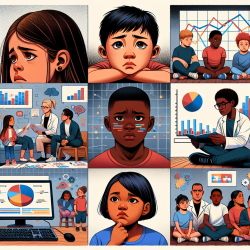Understanding the Impact of Parental Education on Youth Tobacco Norms
As speech-language pathologists and educators, we are constantly seeking ways to improve the outcomes for the children we serve. A recent study published in the International Journal of Environmental Research and Public Health sheds light on the complex relationship between parental educational attainment and perceived tobacco use norms among US youth. This study, conducted by Adinkrah et al., provides critical insights into how these dynamics vary across different racial and ethnic groups.
Key Findings of the Study
The study analyzed data from the Population Assessment of Tobacco and Health (PATH-Youth) study, which followed 4,329 non-smoking youth aged 12 to 17 over four years. The primary focus was on how parental education levels influenced perceived tobacco use norms, with a particular emphasis on racial and ethnic differences.
- Higher parental educational attainment was generally associated with lower perceived tobacco use norms among youth.
- This protective effect was significantly weaker for Latino youth compared to their non-Latino counterparts.
- No significant differences were observed between Black and White youth regarding the influence of parental education on tobacco norms.
Implications for Practitioners
These findings highlight the need for practitioners to consider cultural and contextual factors when addressing tobacco use norms in youth. Here are some actionable steps practitioners can take:
- Tailored Interventions: Develop culturally sensitive interventions that address the unique challenges faced by Latino youth, considering the weaker protective effect of parental education.
- Community Engagement: Engage with community leaders and organizations to create supportive environments that reinforce anti-tobacco norms, particularly in Latino communities.
- Further Research: Encourage further research to explore the underlying factors contributing to these disparities, such as social and environmental influences.
Encouraging Further Research
The study's findings raise important questions about the mechanisms driving the diminished protective effect of parental education among Latino youth. Future research should explore:
- The role of neighborhood and school environments in shaping tobacco norms.
- The impact of targeted advertising and peer influences on youth perceptions of tobacco use.
- Structural inequalities that may contribute to these disparities, such as access to resources and exposure to discrimination.
By understanding these dynamics, practitioners can better support youth in developing healthy behaviors and attitudes toward tobacco use.
Conclusion
While higher parental education is generally associated with lower perceived tobacco use norms, this protective effect is not uniform across all racial and ethnic groups. For Latino youth, the influence of parental education is significantly weaker, underscoring the need for targeted interventions and further research. By addressing these disparities, we can work towards creating healthier outcomes for all children.
To read the original research paper, please follow this link: Race and Ethnic Differences in the Protective Effect of Parental Educational Attainment on Subsequent Perceived Tobacco Norms among US Youth.










